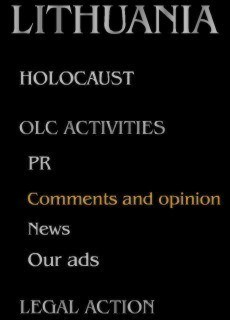|
Hostility to minorities and attempts to rewrite Holocaust history in Baltics - but no one cares, except Russia.
This year marks the 25th anniversary of Baltic independence and more than a decade of full membership in the European Union and NATO. If the assumption was that those developments would cure Lithuanian, Latvian and Estonian society from the scourges of fascism, racism, and anti-Semitism, the events of the past month clearly show that these plagues have not been eradicated. During this period, four separate neo-Nazi/ultra-nationalist marches were held in the Baltics, all of which I attended as a monitor/protester, and I believe that it is important to publicize what I saw and attempt to evaluate the importance and potential dangers posed by those events.
The first question in that regard is the legal status of these marches. Those in Latvia (in Riga on March 16, to honor Latvian SS veterans) and in Lithuania (in Kaunas on February 16 and in Vilnius on March 11, both days on which Lithuanian independence is celebrated) have been a subject of controversy since they were launched, in Latvia in the 1990s and in Lithuania in 2008. Local courts decided to allow the marches on the basis of freedom of speech, and all attempts to have them banned, or at least moved out of the city center, including my appeals this year to the mayors of both Lithuanian cities, have not achieved any practical results.
The second question concerns the sponsors of the events and the number and identity of the marchers. With the exception of Estonia, where the march was organized by the Blue Awakening youth movement, closely linked to the new Conservative People's Party (EKRE), the organizers in Lithuania and Latvia are not officially connected to political parties, but clearly identify with those on the extreme right. In the past, there were government ministers who participated in the SS veterans' march in Latvia, but since the annexation of Crimea, the government has forbidden such participation and last year it cost a minister his post. This year quite a few MP's from the right-wing All for Latvia party marched, and the ministers of justice and of culture, along with Parliament Speaker Ingrida Murnietse, attended a memorial service for the SS.
The number of marchers ranged from 200 in Tallinn to 500 in Kaunas and 1,500 each in Vilnius and Riga. In Estonia, the overwhelming majority of marchers were young - most appeared to be high school students - whereas in Lithuania, most were young adults and in Riga there were also many elderly supporters. One must remember, however, that for every person marching, there are at least several hundred Lithuanians, Latvians, and Estonians who fully agree with the marchers' ideology. Thus, for example, in Estonia's election several days after the march, the EKRE obtained seven parliamentary seats (out of 101), after garnering more than 46,000 votes.
Two dangerous themes were dominant in practically every event. The first was the open hostility toward local minorities - Poles, Russians and Jews in Lithuania, the latter two in Latvia and Estonia. The second was support for ongoing efforts throughout much of post-Communist Eastern Europe to rewrite the narrative of World War II and the Holocaust. These are designed to hide or minimize the extensive crimes by local Nazi collaborators, promote the canard of equivalency between Nazi and Communist crimes (erroneously classified as genocide), and glorify those who fought against the Soviets regardless of whether they had murdered Jews during the Holocaust.
Thus, Latvian SS veterans are portrayed as freedom fighters who paved the way for independence, even though the Nazis had absolutely no intention of granting the Baltic countries sovereignty, and marchers in Kaunas carried a huge banner with the image of Juozas Ambrazevicius, the prime minister of a short-lived provisional Lithuanian government, who publicly supported the Third Reich and lethal measures against Lithuanian Jews. In both Lithuanian cities many marchers wore swastikas, and in Vilnius, a large black SS flag was displayed. Only in Estonia was this theme missing, but each summer an international gathering of SS veterans from all over Europe is held, including from countries in which such meetings are legally banned.
The final question relates to the reactions to the demonstrations. Unfortunately, with the exception of Riga where about two dozen protesters symbolically "fumigated" the Freedom Monument after the SS march, there were very few counter-protesters, 12 individuals in Kaunas, no one besides myself in Tallinn, and about 20 in Vilnius, almost all of whom came thanks to the dedicated efforts of Prof. Dovid Katz, the editor of www.defendinghistory.com who is the sole active Jewish voice in the Baltics against Holocaust distortion.
The only good news was that for the first time since Faina Kukliansky assumed the post of Chairperson of the Lithuanian Jewish community, she issued a statement denouncing the march in Vilnius (after initially ignoring the one in Kaunas), and several community officials participated in our protest. There was only silence from the Jewish communities of Latvia and Estonia, as well as from the Israeli embassies in Vilnius, Riga and Helsinki.
Outside of the region, with the exception of Russia, there were no official responses despite numerous international media reports, especially about the Riga march. I can only surmise that perhaps the incessant, and to a large extent justified (albeit often exaggerated) criticism from Moscow of this phenomenon, has silenced those in the West, who long ago should have been the first to object.
i24news.tv
| 

